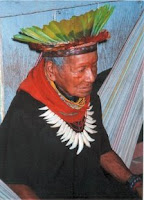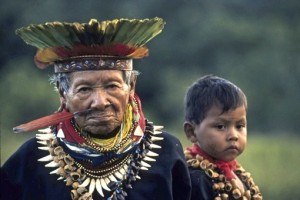Shamans in the Amazon are not unaware of the problems brought about by their encounter with global modernity. On June 1 through 8, 1999, forty of the most prominent traditional healers from seven indigenous peoples convened in Yurayaco, Colombia, to hold an Encuentro de Taitas, a Meeting of Shamans, and to discuss the future of traditional medicine. One result of that meeting was the publication of two documents — a Código de ética de la medicina indígena del piedemonte Amazónico Colombiano, Code of Ethics of Indigenous Medicine of the Foothills of the Colombian Amazon, and the Declaración del Encuentro de Taitas, Declaration of the Meeting of Shamans, often called the Yurayaco Declaration.
 |
| Kofán taita Fernando Mendúa Queta, reported to be 118 years old, is a member of the Council of Elders of UMIYAC |
In addition, under a grant from the Amazon Conservation Team (ACT), an environmental group with headquarters in Washington, DC, a very handsome commemorative volume was published, with striking color photographs of the participants and events. Another result was the formation of an organization, the Unión de Médicos Indígenas Yageceros de la Amazonía Colombiana (UMIYAC), the Union of Indigenous Yagé Healers of the Colombian Amazon, with the purpose, among other things, of establishing a certification procedure for shamans, apprentices, and disciples.
The Yurayaco meeting recognized a number of problems with which the Declaration and Code of Ethics were intended to deal. These included disunity among shamans; discrediting of indigenous medicine by blancos; disbelief in medicine and medicinal plants, and disrespect for shamans, among indigenous youth; belief by gente blanca that yagé is a harmful drug of no benefit; depletion of the rainforest, yagé, and medicinal plants; indigenous charlatans; misuse of yagé by non-indigenous people; trade in yagé and other medicinal plants; the problem of patents and ownership of plants; possible prohibition of yagé; and relationship with the government health system.
The Declaration consists of fourteen points. For example, declaration number three states:
Non-indigenous peoples are now acknowledging the importance of our wisdom and the value of our medicinal and sacred plants. Many of them desecrate our culture and our territories, traffic in yagé and other plants, dress like Indians, and act like charlatans. We note with concern that a new form of tourism is being promoted to deceive foreigners with purported services of taitas or shamans in several villages in the Amazon foothills. Even some of our own indigenous brothers do not respect the value of our traditional medicine and go around the villages and cities selling our symbols and misleading people.
The Declaration concluded with a request for support from non-indigenous peoples, an agreement to “work for the unity and defense of traditional medicine and offer our services for the health of indigenous peoples and humanity,” and three concrete proposals — to initiate a certification process and code of ethics for practitioners of indigenous medicine, in order to facilitate recognition of the difference between taitas and charlatans; to travel throughout the Americas to bring the benefits of their medicine to indigenous peoples, and to construct indigenous medical clinics for non-indigenous peoples as well; and to create UMIYAC, the Union of Indigenous Yagé Healers of the Colombian Amazon.
 |
A similar but apparently less politicized organization has also been established in Iquitos — Asociación de Médicos Vegetalistas de Iquitos (ASMEVEI), the Iquitos Association of Plant Healers. Formed on June 17, 2001, under the sponsorship of the prestigious Instituto de Investigaciones de la Amazonía Peruana (IIAP), a governmental research institute, the goal of the organization is primarily to promote the use of traditional plant healing practices, train new plant healers, and promote the conservation of medicinal plant resources. As of 2003, two years after its founding, the organization had 32 member practitioners. As far as I can tell, the organization has been static since that time.
The effect of such an attempt at organization and professionalization is not yet clear. To the extent that certification processes are established, they can be used politically against unpopular shamans and their apprentices, and they can constitute entry barriers that protect the interests of established shamans. Nor is it clear to what extent shamans either in Perú or Colombia would be willing to sacrifice their autonomy and individuality, nor to what extent noble intentions might be subverted by envidia and accusations of brujería — in other words, by shamanic business as usual.

- Previous Post: Ayahuasca Admixtures
- Next Post: Ayahuasca in the Supreme Court
- More Articles Related to: Ayahuasca, Indigenous Culture, Shamanism, The Amazon


